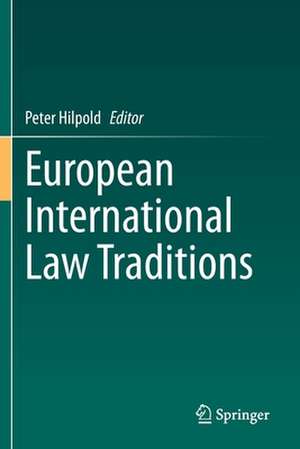European International Law Traditions
Editat de Peter Hilpolden Limba Engleză Paperback – 11 apr 2022
The reality, however, is quite different. Individual countries’ approaches to International Law, and the meanings attached to different concepts, often diverge considerably. The result is a lack of comprehension that can ultimately lead to outright conflicts.
In this book, several renowned international lawyers engage in an enquiry directed at sorting out how different European nations have contributed to the development of International Law, and how various national approaches to International Law differ. In doing so, their goal is to promote a better understanding of theory and practice in International Law.Chapter “What Are and to What Avail Do We Study European International Law Traditions?” is available open access under a Creative Commons Attribution 4.0 International License via link.springer.com.
| Toate formatele și edițiile | Preț | Express |
|---|---|---|
| Paperback (1) | 892.42 lei 6-8 săpt. | |
| Springer International Publishing – 11 apr 2022 | 892.42 lei 6-8 săpt. | |
| Hardback (1) | 898.58 lei 6-8 săpt. | |
| Springer International Publishing – 20 noi 2020 | 898.58 lei 6-8 săpt. |
Preț: 892.42 lei
Preț vechi: 1088.31 lei
-18% Nou
Puncte Express: 1339
Preț estimativ în valută:
170.78€ • 185.45$ • 143.46£
170.78€ • 185.45$ • 143.46£
Carte tipărită la comandă
Livrare economică 22 aprilie-06 mai
Preluare comenzi: 021 569.72.76
Specificații
ISBN-13: 9783030520304
ISBN-10: 3030520307
Ilustrații: VIII, 339 p. 1 illus.
Dimensiuni: 155 x 235 mm
Greutate: 0.49 kg
Ediția:1st ed. 2021
Editura: Springer International Publishing
Colecția Springer
Locul publicării:Cham, Switzerland
ISBN-10: 3030520307
Ilustrații: VIII, 339 p. 1 illus.
Dimensiuni: 155 x 235 mm
Greutate: 0.49 kg
Ediția:1st ed. 2021
Editura: Springer International Publishing
Colecția Springer
Locul publicării:Cham, Switzerland
Cuprins
What are and to what avail do we study European International Law Traditions? by Peter Hilpold.- The Concept of International Law – The German Perspective by Christian Tomuschat.- The 'Austrian School of International Law' – The influence of Austrian international lawyers on the formation of the present international legal order by Heribert Franz Köck.- The Concept of International Law: The Italian Perspective by Carlo Focarelli.- The French Tradition of International Law by Andrea Hamann.- British Contributions to Public International Law by Michael Wood.- Exploring Belgian and Dutch “Traditions” in International Law by Jan Wouters and Nina Pineau.- International Law from a Nordic Perspective by Astrid Kjeldgaard-Pedersen and Jakob v.H. Holtermann.- The Russian Concept of International Law as Imperial Legacy by Lauri Mälksoo.- International Adjudication under Particular Consideration of International Criminal Justice: The German Contribution by Stefanie Bock.- The development of International Economic Law - Contributions of German-Speaking Countries by Ernst-Ulrich Petersmann.
Notă biografică
Dr. Peter Hilpold is Professor of International Law, EU Law and Public Comparative Law at the University of Innsbruck. He holds several University degrees (law, economics, industrial management, languages) and has been granted a series of academic awards. He is a co-editor of the journal “Europa Ethnica” and a member of the Editorial Board of the “Austrian Review of International and European Law”. Futhermore, he is a member of the Advisory Board of the “Hague Yearbook of International Law” as well as of the journal “Diritti Umani e Diritto Internazionale”. He is also a permanent collaborator of the journal “Archiv des Völkerrecht” and the author of over 250 publications.
Textul de pe ultima copertă
International Law is usually considered, at least initially, to be a unitary legal order that is not subject to different national approaches. Ex definition it should be an order that transcends the national, and one that merges national perspectives into a higher understanding of law. It gains broad recognition precisely because it gives expression to a common consensus transcending national positions.
The reality, however, is quite different. Individual countries’ approaches to International Law, and the meanings attached to different concepts, often diverge considerably. The result is a lack of comprehension that can ultimately lead to outright conflicts.
In this book, several renowned international lawyers engage in an enquiry directed at sorting out how different European nations have contributed to the development of International Law, and how various national approaches to International Law differ. In doing so, their goal is to promote a better understanding of theory and practice in International Law.Chapter “What Are and to What Avail Do We Study European International Law Traditions?” is available open access under a Creative Commons Attribution 4.0 International License via link.springer.com.
Caracteristici
Written by renowned international lawyers
Contributes to a better understanding of theory and practice in International Law
Reviews the historical development of International Law from the perspectives of various European countries
Provides an overview on the rich panoply of past writings on International Law
Aims at promoting a common perspective on International Law
Provides tools for refining the common language of International Law
Aims at further strengthening International Law as an effective, internationally accepted, recognized and respected legal order
Contributes to a better understanding of theory and practice in International Law
Reviews the historical development of International Law from the perspectives of various European countries
Provides an overview on the rich panoply of past writings on International Law
Aims at promoting a common perspective on International Law
Provides tools for refining the common language of International Law
Aims at further strengthening International Law as an effective, internationally accepted, recognized and respected legal order
